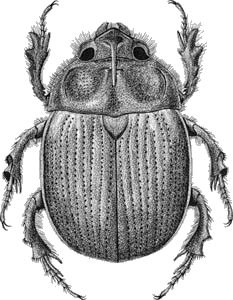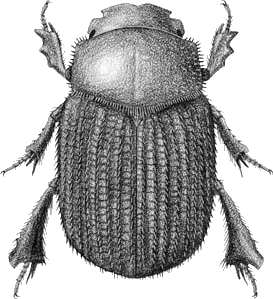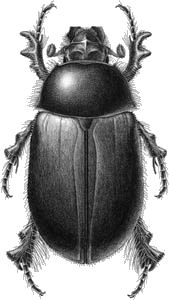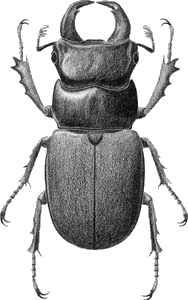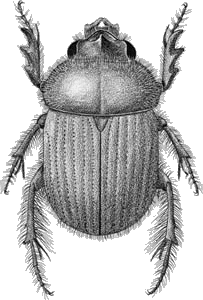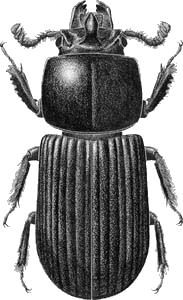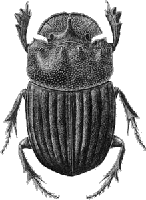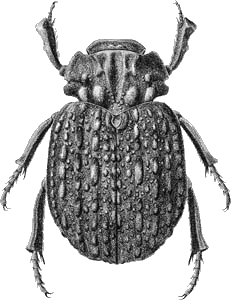

SUPERFAMILY SCARABAEOIDEA - SCARABAEOID BEETLES (LAMELLICORNIA)
A large, diverse and cosmopolitan group of beetles, generally of significant size, frequently brightly-coloured and many bearing charismatic horns and adornments that make them popular study subjects. Scarabaeoid beetles have adapted to a variety of lifestyles and many species show aspects of parental care and even sociability. Members of this superfamily possess the following characteristics:
1 Lamellate antennal clubs.
2 Highly modified protothorax (for burrowing) with large coxae.
3 Protibiae dentate with a single spur.
4 Reduced wing venation.
5 Tergite 8 not concealed by tergite 7.
6 Cylindrical, crescent-shaped larvae.
The Scarabaeoidea is one of the largest Coleopteran superfamilies with somewhere in the region of 31,000 described species in more than 2200 genera. The taxonomy of some groups is in disarray and species limits are unclear. Under the most recent taxonomy 11 New World families make up this Superfamily of which 8 are present in Paraguay. See below for a summary of the familial characteristics for Paraguayan taxa.
Relevant Resources
Generic Guide to New World Scarab Beetles - A thorough and well-presented online guide to the American members of the Scarabaeoidea Superfamily produced by the University of Nebraska State Museum. Includes information and keys for all New World taxa. All external links on this page link to the relevant sections of the Generic Guide to New World Scarab Beetles and all information included on this page was adapted from this online resource which should be cited as the source reference (see home page for correct mode of citation).
Key to the Families and Subfamilies of Scaraboidea - Taken from the above page, this can be downloaded in pdf format here and includes all the New World families. Follow links in the text below for keys to the component groups.
Click on the representative beetle icon to the right for the relevant pages of the Generic Guide to New World Scarab Beetles where you will find more detailed information about each family group.
Click on the family links for access to the FAUNA Paraguay image galleries.
Thanks to Brett Ratcliffe and Mary Liz Jameson for their assistance with information about Scarabaeoidea and permission to reproduce the information on this page.
Designed by Paul Smith 2006. This website is copyrighted by law. Material contained herewith may not be used without the prior written permission of FAUNA Paraguay. Photographs on this web-site were taken by Paul Smith, Hemme Batjes, Regis Nossent,
Alberto Esquivel, Arne Lesterhuis, Rebbeca Zarza, Josť Luis Cartes and Hugo del Castillo and are used with their permission.

Family Geotrupidae - Earth-boring Dung Beetles
Length: Small to medium-sized 5-45mm
Characteristics: Body ovaloid. Colour yellow, brownish, purple or black with or without metallic sheen. Antennae 11 segmented with three-segmented club. Clypeus often with horn. Convex pronotum with base wider than or equal to elytral base. Tarsal formula 5-5-5 with claws equal and simple. Abdomen with 6 free sternites. Wings well-developed.
Classification: Two subfamilies Bolboceratinae (including tribes Bolboceratini and Athyreini) and Geotrupinae (including tribes Geotrupini and Taurocerastini). Only the Athyreini and Taurocerastini are present in Paraguay.
Life Cycle: Spend most of their life in burrows. Diet varies between species, often coprophagous. Adults do not tend larvae but provision them with food in burrows, often under dung. Mainly nocturnal and some species are attracted to lights at night.
Family Glaresidae - Glaresid Beetles
Length: Small 2.5-6mm
Characteristics: Body oblong-ovoid and convex. Light or dark brown in colouration with fine hairs on dorsal surface. Antennae 10 segmented with three-segmented club. Clypeus lacks turbercle or horn. Pronotum short, broad and convex. Elytra convex with 10 distinct costae. Tarsal formula 5-5-5 with claws equal and simple. Abdomen with 5 free sternites. Wings well-developed.
Classification: This family contains a single genus Glaresis Erichson 1848 distributed on all major continents.
Life Cycle: Found in dry sandy areas and often attracted to lights. It has been hypothesised that they feed on subterranean fungi. Adults stridulate weakly when handled.
Family Hybosoridae - Hybosorid Scarab Beetles
Length: Small 5-7mm.
Characteristics: Body oval and convex. Light brown to shining black in colour. Antennae 10 segmented with three-segmented opposable club. Clypeus lacks turbercle or horn. Pronotum convex with base wider than base of elytra. Elytra convex with polished surface. Tarsal formula 5-5-5 with claws equal and simple. Abdomen with 6 free sternites, first obscured by lateral coxae. Wings well-developed.
Classification: Represented in Paraguay by two subfamilies Anaidinae and Ceratocanthinae. A key to the genera of Anaidinae by Federico Ocampo is available here.
Life Cycle: Most species little known. Feed on dung, carrion and rotten wood and often associated with ant nests. Some species capable of rolling in a compact ball. Larvae and adult of some species stridulate.
Family Lucanidae - Stag Beetles
Length: Typically large 10-90mm
Characteristics: Body weakly convex, elongate or cylindrical. Colour black or reddish-brown, sometimes slightly metallic. Dorsum sometimes scaled. Antennae 10 segmented straight or geniculate, with 3 to 7 segmented club. Mandibles prominent and often elongated in males. Pronotum variably convex with or without tubercles. Elytra weakly convex. Tarsal formula 5-5-5 with claws equal and simple. Abdomen with 5 or 6 visible sternites. Wings well-developed.
Classification: Two subfamilies have been recorded in Paraguay, the Lucaninae and the Syndesinae.
Life Cycle: Associated with forested habitats, eggs being laid in crevices where larvae feed on decaying wood. Sometimes attracted to lights. Males of some species use the enlarged mandibles in aggressive encounters.
Family Ochodaeidae - Ochodaeid Scarab Beetles
Length: Small 3-10mm.
Characteristics: Body elongate and convex. Colour yellowish, brown or black, rarely bicoloured. Antennae with 9 or 10 segments and 3 segmented club. Clypeus simple, sometimes with tubercle on anterior margin. Pronotum convex, lacking adornments. Elytra convex, with or without stria, often punctate or granulose. Tarsal formula 5-5-5 with claws equal and simple. Abdomen with 5 or 6 visible sternites. Wings well-developed.
Classification: The New World taxa of this family can be split into two subfamilies the Ochodaeinae and the Chaetocanthinae, containing four genera.
Life Cycle: Adults of most species are nocturnal and are often attracted to light - frequently in large numbers. Little is known of the biology of this group.
Family Passalidae - Bess Beetles
Length: Typically large 15-70mm.
Characteristics: Body elongate, cylindrical and depressed. Colour black, ventral surface sometimes with yellowish setae. Head narrower than thorax often with dorsomedian horn. Antennae 10 segmented with three-segmented club. Mandibles large, curved, toothed and blunt. Elytra elongated and striated, with parallel sides and rounded apex. Tarsal formula 5-5-5 with claws equal and simple. Abdomen with 5 visible sternites. Wings well-developed.
Classification: This family is monophyletic. A key to the New World genera of Passalidae is available to download in English or in Spanish.
Life Cycle: Adults and larvae live together in social groups in rotting wood. Eggs usually red when freshly laid, fading to brown and then green. Adults and larvae communicate by stridulating. Adults and larvae feed on adult faeces predigested by microflora. Adults may chew food and feed it to larvae.
Family Scarabaeidae - Scarab Beetles
Length: Tiny to huge 2-180mm.
Characteristics: Body shape and colour variable. Antennae with 9-10 segments and club with 3 to 7 segments. Clypeus and pronotoum may or may not possess horns. Elytra sometimes striated and may be convex or flattened. Tarsal formula 5-5-5, anterior tarsi absent in some Scarabaeinae. Abdomen with 6 visible sternites. Wings well-developed.
Classification: At least seven of the nine New World subfamilies are present in Paraguay and each subfamily is split into a great many tribes. The subfamilies recorded in Paraguay include Aphodiinae (Aphodiine Dung Beetles), Cetoniinae (Flower Chafers), Dynastinae (Rhinoceros Beetles), Melolonthinae (Chafers), Orphninae (Orphnine Beetles), Rutelinae (Shining Leaf Chafers) and Scarabaeinae (Dung Beetles). Click the links for more information on each subfamily and their component tribes from Generic Guide to New World Scarab Beetles.
Life Cycle: Life cycles vary greatly in this group. Some species are dung feeders and play important roles in recycling, others are pollen feeders and important pollinators. Both nocturnal and diurnal species occur in this group.
Family Trogidae - Skin Beetles
Length: Tiny to small 2.5-20mm.
Characteristics: Body shape oblong-oval and convex. Colour grey, brown or black with warty, dirt-encrusted appearance. Abdomen flattened. Antennae with 10 segments and club with 3 to 7 segments. Clypeus lacks horn. Mandibles with mandibular brush. Pronotum short, broad and convex with ridges, depressions and tubercles. Elytra convex with striae and ridged intervals. Tarsal formula 5-5-5, claws simple. Abdomen with 5 free sternites. Wings well-developed. Larvae with well-developed lateral ocelli - unique in the Superfamily.
Classification: This family is monophyletic.
Life Cycle: Adults and larvae are carrion feeders, amongst the last visitors to a carcass where they feed on feathers, fur and skin. Many species have specialised associations with bird or mammal nests. Some are attracted to lights at night. When disturbed adults feign death. Adults stridulate but larvae do not.
